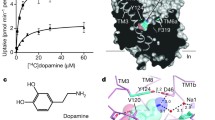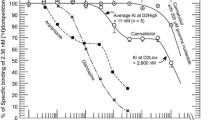Summary
Dopamine recognized and competed for a single population of [3H]-domperidone-binding sites in rat striatum and olfactory tubercle when tested in the presence of sodium ions and guanine nucleotide [Gpp(NH)p]. In the absence of Na+ and Gpp(NH)p, however, dopamine recognized two components of [3H]-domperidone binding. Thus, [3H]-domperidone labelled only a single population of dopamine receptors (type D2) which fully converted from high to low affinity for dopamine. These results agree with those found previously using [3H]-spiperone and [3H]-YM-09151-2.
Similar content being viewed by others
References
Baudry M, Martres MP, Schwartz JC (1979)3H-Domperidone: A selective ligand for dopamine receptors. Naunyn-Schmiedeberg's Arch Pharmacol 308:231–237
Fleming WW, Westfall DP, De la Lande IS, Jellet LB (1972) Lognormal distribution of equieffective doses of norepinephrine and acetylcholine in several tissues. J Pharmacol Exp Ther 181:339–345
George SR, Watanabe M, Seeman P (1985) Dopamine D2 receptors in the anterior pituitary: A single population without reciprocal antagonist/agonist states. J Neurochem 44:1168–1177
Grigoriadis D, Seeman P (1984) The dopamine/neuroleptic receptor. Can J Neurol Sci 11:108–113
Grigoriadis D, Seeman P (1985) Complete conversion of brain D2 dopamine receptors from the high- to the low-affinity state for dopamine agonists, using sodium ions and guanine nucleotide. J Neurochem 44:1929–1935
Hamblin MW, Leff SE, Creese I (1984) Interactions of agonists with D-2 dopamine receptors: Evidence for a single receptor population existing in multiple agonist affinity states in rat striatal membranes. Biochem Pharmacol 33(6):877–887
Huff RM, Molinoff PB (1982) Quantitative determination of dopamine receptor subtypes not linked to activation of adenylate cyclase in rat striatum. Proc Nat Acad Sci (USA) 79:7561–7565
Jenner P, Elliott PNC, Clow A, Reavill C, Marsden CD (1978) A comparison of in vitro and in vivo dopamine receptor antagonism produced by substituted benzamide drugs. J Pharm Pharmacol 30:46–48
Lazareno S (1983) Effects of GTP on3H-domperidone binding and its displacement by dopamine in rat striatal homogenates. J Recept Res 3(1&2):163–175
Leysen JE, Niemegeers CJE, Van Neuten JM, Laduron PM (1978) Spiperone: A ligand of choice for neuroleptic receptors. 1. Kinetics and characteristics of in vitro binding. Biochem Pharmacol 27:307–316
Martres MP, Baudry M, Schwartz JC (1978) Characterization of3H-domperidone binding on striatal dopamine receptors. Life Sci 23:1781–1784
Munson PJ, Rodbard D (1980) A versatile computerized approach for characterization of ligand-binding systems. Anal Biochem 107:220–239
Niznik HB, Grigoriadis D, Pri-Bar I, Buchman O, Seeman P (1985) Dopamine D2 receptors selectively labeled by a benzamide neuroleptic: [3H]-YM-09151-2. Naunyn-Schmiedeberg's Arch Pharmacol 329:333–343
Sokoloff P, Martres MP, Delandre M, Redouane K, Schwartz JC (1984)3H-Domperidone binding sites differ in rat striatum and pituitary. Naunyn-Schmiedeberg's Arch Pharmacol 327:221–227
Sokoloff P, Protais P (1984b) In: Woodruff GN, Creese I, Gessa GL, Hornykiewicz O, Poat JA, Roberts PJ (eds) Dopaminergic systems and their regulation. Macmillan Press, London (in press)
Sokoloff P, Redouane K, Brann M, Martres MP, Schwartz JC (1985)3H-(−)DO 710 discriminates guanine nucleotide sensitive and insensitive dopamine binding sites. Naunyn-Schmiedeberg's Arch Pharmacol 329:236–243
Wreggett KA, Seeman P (1984) Agonist high-and low-affinity states of the D2 dopamine receptor in calf brain: Partial conversion by guanine nucleotide. Mol Pharm 25:10–17
Zahniser NR, Molinoff PB (1978) Effect of guanine nucleotides on striatal dopamine receptors. Nature 275:453–455
Author information
Authors and Affiliations
Rights and permissions
About this article
Cite this article
Grigoriadis, D., Seeman, P. [3H]-Domperidone labels only a single population of receptors which convert from high to low affinity for dopamine in rat brain. Naunyn-Schmiedeberg's Arch. Pharmacol. 332, 21–25 (1986). https://doi.org/10.1007/BF00633192
Received:
Accepted:
Issue Date:
DOI: https://doi.org/10.1007/BF00633192




